So, you made it through one of the hardest parts of writing a screenplay; you created your characters. From childhood trauma to adulthood adventures, you’ve fleshed out your entire character backstory. You should be excited to move forward.
Any main character of any compelling story has to have a backstory to match. And anytime you write a character whose story deserves to be told, it’s important for the audience to know your character’s entire history so they love your character as much as you do…right?
Not so much.
A character’s backstory is what made them into who they are at the start of your story. And that’s exactly why you shouldn’t overload your audience with it. If viewers have to spend too much time on your character’s past, they’re going to lose interest in the present, not to mention what comes next.
So, what are you supposed to do when you only have 90 pages for your entire story but years of character backstory prepared? Let’s take a look at 7 efficient ways to put character backstory into your screenplay effectively.
Table of Contents
7 Ways to Weave Character Backstory into Your Screenplay
1. Fly Under the Radar
No audience wants to sit in a theater and listen to characters tell story after story. You can afford maybe one Jaws U.S.S. Indianapolis style story in your screenplay, and it had better serve a purpose. But nine times out of ten, you’re better off with something more subtle.
If there’s something you want the audience to know about your character, the first thing you should ask yourself is, “how can I say this without saying it?” Is there something your character can say that doesn’t sound like character backstory, but alludes to a prior event?
One of the best ways to do this is by strategically analyzing your own plot. Let’s say you want to hint at a meltdown your character had last year. When in your story is that trauma affecting them the most? In moments of strong emotion, they might let something slip they’d rather have kept inside.
Remember that if your character is sufficiently flawed, they can be their own worst enemy. Think of how you can disguise character backstory inside plot complications. A character does something rash; maybe their best friend is completely unsurprised. They, therefore, must pull stunts like this all the time.
An expert example from The Godfather
Take this early dialogue in The Godfather, for example. This looks like simple exposition about Luca Brasi. In reality, it’s cleverly disguised character backstory for Michael Corleone.
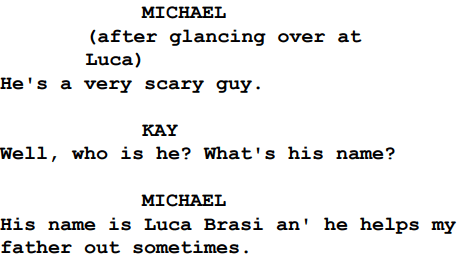
Straight away the audience knows two things about Michael: he isn’t a part of his father’s business, and he finds it intimidating. Past that, viewers can also infer that Michael has a decent idea of what goes on in the Corleone family’s criminal exploits.
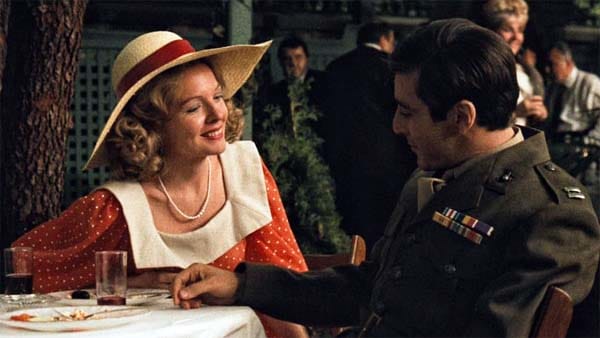
In just a few lines, the writer uses elements of Michael’s backstory to actively involve the audience. How will this outsider son in a military uniform become entangled in the crime family? How did he end up so different from his brothers?
This is one of many ways you can keep your character backstory feeling natural. Make it barely noticeable. Tell your viewers about your character’s history without letting them know that’s what you’re doing.
2. Keep the Tension
Having subtlety with your character backstory is one thing, but making sure it fits comfortably into your story is another. There are appropriate times and settings for everything your audience needs to know.
Using timing to your advantage is a supremely effective way to both find the most opportune moment to reveal something about your character, and to maximize the storytelling impact of character backstory.
If you reveal your entire character too quickly, it could lead to the rest of your screenplay being a little too predictable. Audiences like to put two and two together. Let them wonder why your character is doing something. Let that lack of information build tension and curiosity.
Then, when the story calls for it, make it click with strategically placed backstory. Release the tension when it is at its peak. When you approach backstory this way, not only does your character backstory fit seamlessly into your script, but it also punches up the impact.
A great way to make sure you are doing this throughout your screenplay is to track it. Make a note for every time you are teasing some backstory and see if it’s consistently present, where and when it falls and how and when it could feature more or less.
3. Give Backstory a Role
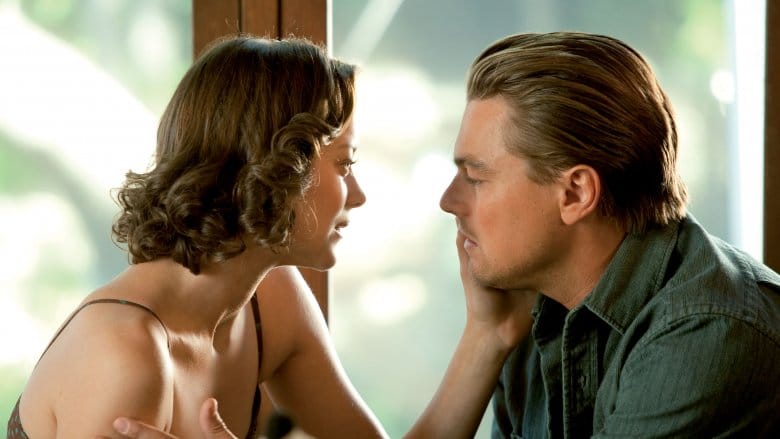
A more direct method of injecting backstory into your screenplay is to give it a role to play within the plot itself. Though you shouldn’t use this method every time, when used properly, it can add a new dimension to your character.
Let’s look at an example from Inception. The biggest question mark throughout the film is what the deal is with Cobb’s wife, Mal. Why is she on a murderous rampage in his dreams? What happened to her? Christopher Nolan keeps this backstory at the heart of the plot.
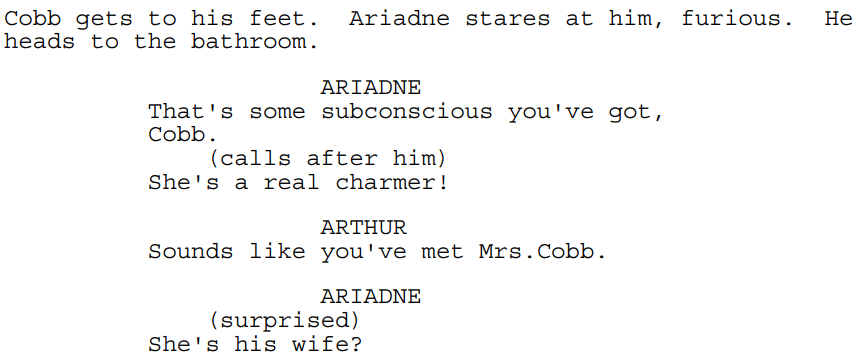
Mal attacks Ariadne in a shared dream, causing her to wake up. Though this scene doesn’t reveal any new information, it gives Cobb’s mysterious past a direct role in the plot. This projection of his wife is threatening to jeopardize their mission.
Though Nolan isn’t so subtle with his reveal–he opts for a series of flashbacks–his choice to use Cobb’s character backstory as a plot device gives the big reveal the weight of a major plot point. So Cobb’s story doesn’t seem as much of a backstory as it seems like an important discovery.
4. Find Comfortable Moments
Sometimes, your character telling another character about their past feels natural. But you have to be methodical about finding those moments. What you’re telling the audience has to feel relevant to that part of the story, or it’ll just be awkward.
The closer the relationship between characters in a scene, the more appropriate it feels to put character backstory into dialogue. Depending on the dynamics of the relationship, it may even make sense for a character to ask questions about another character’s past.
Let’s look at The Power of the Dog, for example. Throughout the film, Phil Burbank, Benedict Cumberbatch‘s character, develops a mentor-like role to Peter, played by Kodi Smit-McPhee. Late in the third act, Peter asks about Bronco Henry, Phil’s own late mentor:
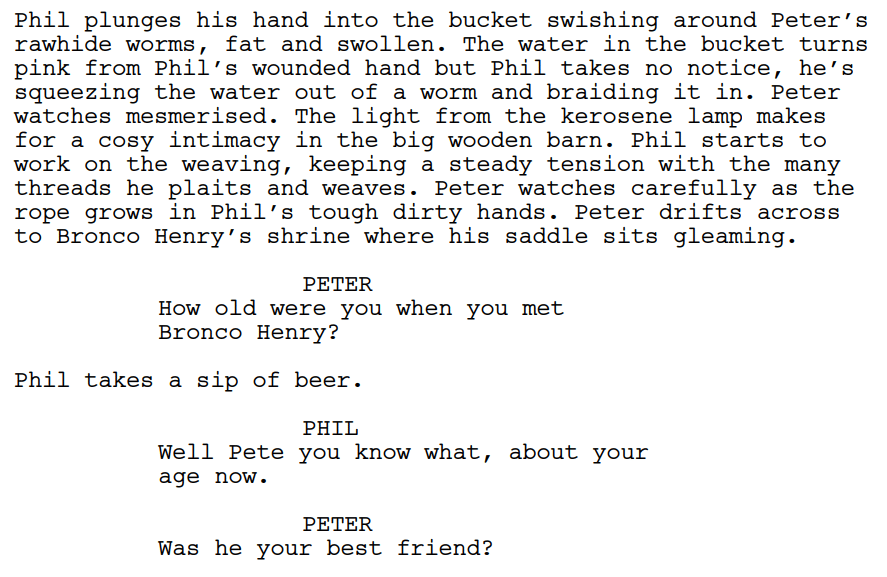
The timing here is perfect. Phil’s reverence for Bronco Henry and Peter’s eagerness to connect with Phil makes this an ideal moment for character backstory, especially with Bronco Henry’s saddle in eyeshot. Peter is rolling Phil a cigarette, and they’re spending intimate time together. It flows.
Moments like these can’t be half-assed. When you opt for question and answer style character backstory, it’s important to be aware that you’re toeing the line between natural backstory and clunky exposition.
Be careful with moments of reminiscence, and make sure someone in the scene is learning along with the audience. Though there are opportunities to use this type of character backstory in your script, don’t overdo it.
Too much verbal storytelling is a drag and will lose the audience’s attention. Make sure the dialogue is therefore tied to other things in the scene. This needs to be something that prompts the character but also feels natural within the scene and not just transparently there to act as a prompt.
5. Use the Environment
So, like Jane Campion’s use of setting in the scene above, setting the scene with care gives your writing an advantage. Though the scene still works without Bronco Henry’s shrine, setting the scene that way gives an added significance to Peter’s question.
Physical surroundings are powerful when it comes to memories. When you visit your parents’ house, memories of childhood are all around you. If you’re at the airport, you might remember saying goodbye to someone. And of course, seeing a certain person can change a character’s whole demeanor.
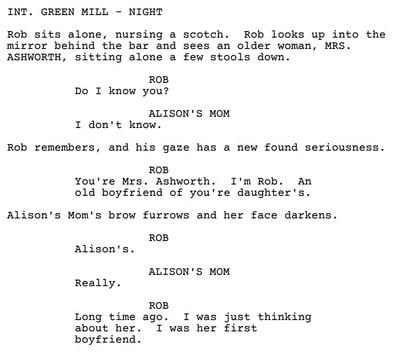
This scene in High Fidelity uses environment in a couple of ways.
- Firstly, Rob sulks at a bar after a discouraging call with his ex-girlfriend.
- Secondly, he coincidentally sits right down the bar from his high school girlfriend’s mother.
Knowing the character of Rob, he’s already sitting there thinking about all his past breakups. So the writers use the character and his environment to bring about both backstory and a beat. He goes on to learn that Alison married the boyfriend after him; it was fate.
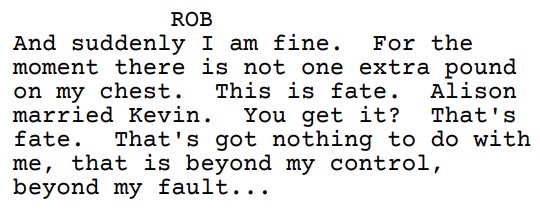
The writers here, like in The Power of the Dog, use the scene’s environment to pull out character backstory and story progression. Phil’s backstory shows him the value of his relationship with Peter, and Rob’s backstory frees him from his own relationship insecurities.
A scene’s setting has a lot of power. Film is a medium for visual storytelling, and if you’re putting everything on the screen to good use, you’re being efficient with your own storytelling. Sometimes, you don’t even need words to take advantage of what’s on-screen…
6. Take Advantage of Visuals, Action and Internal Conflict
The sneakiest way to illustrate character backstory is without using any dialogue at all. With the use of objects and actions, oftentimes you can hint at an event in a character’s past, letting your audience figure it out themselves.
One of the most common ways of doing this is through photos. Having a character interact with a photograph can be a quick way to introduce a dead loved one to their backstory, for example. But you can get more adventurous than that.
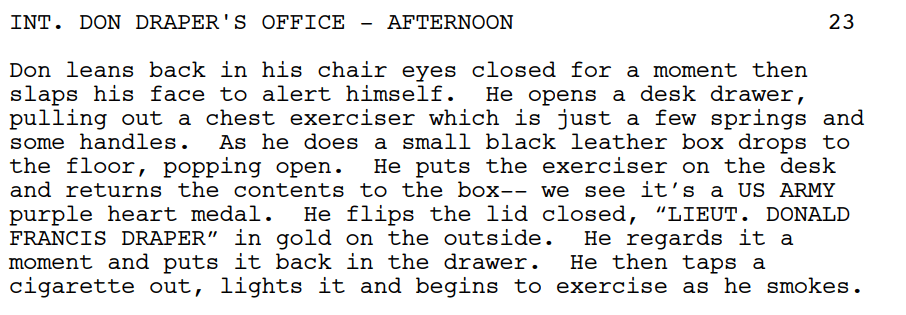
This scene from the Mad Men pilot uses no dialogue, and yet reveals character backstory for Don Draper while simultaneously introducing more questions about him.
- We learn Don served in the army, but question why he has a purple heart, and why he keeps it in his office. Both are pieces of backstory that will come to light later in the series.

Viewers appreciate autonomy. Nobody likes to have a film or show explain things they could have figured out themselves. This is why this type of character backstory is so effective.
Moreover, this method eschews the use of dialogue. It’s rare that you’ll get through an entire screenplay without using some dialogue to convey character backstory. But it should be all about balance. And using internal conflict can go a long way to achieving this balance.
- How does the character react to a certain image, object or environment?
- How do their demeanour and attitude noticeably change?
- What are their consequent actions?
These kinds of responses can be essential in conveying backstory, tying an emotional state to something visual. It’s a cinematic, tangible and immersive way of illustrating a character’s history.
7. Be Minimalistic
Your audience doesn’t need to know anywhere near as much character backstory as you do. They only need to know enough to absorb the story and believe the characters’ actions. Anything past that is gratuitous. This is where the classic saying “kill your darlings” comes into play.
If the reason you put a piece of character backstory in is just that you like it, take it out. Then think, “now that’s gone, what have I lost?” If your story functions just the same without it, your script is better off with it gone.
- Once you’ve clued your audience in enough, loosen the reins and let your story breathe.
- If you have a strong character, you won’t need loads of backstory to get the audience invested.
- Give the audience questions to ask, then reveal the answers down the road. Or leave them open-ended.
Have confidence in your characters. If you find yourself feeling the need to pad your characters with backstory to get your screenplay going, maybe it’s time to take a few steps back and see if you weren’t a little bit too quick to leave the outline phase, or if you have an incomplete protagonist.
Moreover, try an exercise where you challenge yourself to replace lengthy pieces of character exposition with something much simpler. If you can’t boil backstory down to an object, image, expression or line of dialogue then it’s perhaps something that isn’t going to work in the midst of your plot.
You might not reach the full extent of backstory with a symbol that you would with a handful of scenes or lengthy exchanges of dialogue. But where there is loss, there is gain in structural efficiency, tension and narrative propulsion.

In Conclusion
One of the most important things in screenwriting is making sure your audience/reader doesn’t drift off and get bogged down in unnecessary detail. Simply put, you have to leave the audience wanting more.
It’s natural to want the viewer to understand everything about your character. But you have to balance this with the plot, other characters and thematic purpose.
So whilst it’s a worthwhile, even essential, exercise to flesh out your character bio as much as possible, you have to exercise perfect restraint when it comes to filtering this character backstory through your actual script.
The above steps are crucial ways of making sure you’re not overloading your script with character backstory and ultimately keeping the story moving forward, engaging, dramatic and cinematic.
– What did you think of this article? Share It , Like It , give it a rating, and let us know your
thoughts in the comments box further down…
–Struggling with a script or book? Story analysis is what we do, all day, every day…
check out our range of script coverage services for writers & filmmakers.
This article was written by Andy Fialko and edited by IS Staff.
Get *ALL* our FREE Resources
Tackle the trickiest areas of screenwriting with our exclusive eBooks. Get all our FREE resources when you join 60,000 filmmakers on our mailing list!

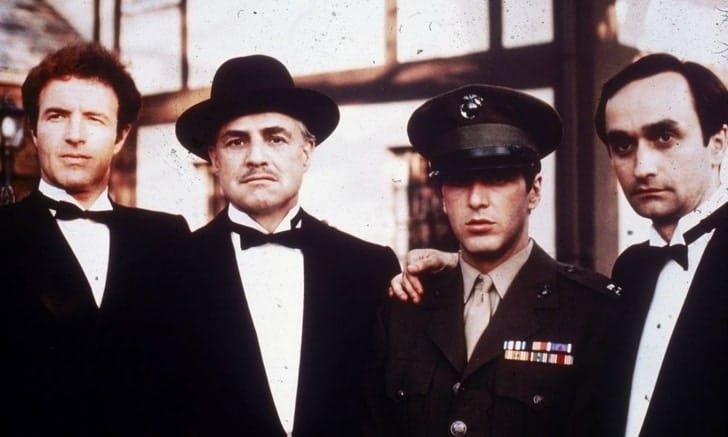
the information about subtlety, etc. in backstory was very helpful